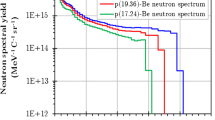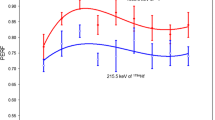Abstract
Fluorine is an important trace element for life and human well-being. Food, in general, provides about 40 percent of the fluorine intake in the human body. In order to measure fluorine levels in human diet samples, Instrumental Neutron Activation Analysis (INAA) and Proton Induced Gamma-ray Emission (PIGE) analysis were used. Reactions19F(n,γ)20F and19F(n, p)19O were employed for determination of the fluorine concentration using a reactor neutron spectrum and epithermal neutrons. Corrections were made for the sodium matrix interference caused by the23Na(n, α)20F threshold reaction in the case of reactor neutron cyclic activation analysis and for the oxygen interference via18O(n, γ)19O reaction when using the epithermal cyclic NAA method. The fluorine content of the diet samples was also determined by PIGE analysis making use of the resonance reaction19F(p, αγ)16O at 872 keV. Cyclic Neutron Activation Analysis (CNAA) when combined with mass fractionation was found to be the most suitable for determination of low concentration of fluorine, through the19F(n, γ)20F reaction with a detection limit of 2.2 ppm in Bowen's Kale elemental standard.
Similar content being viewed by others
References
J. C. BAILAR, H. J. EMELEUS, Comprehensive Inorganic Chemistry, Pergamon Press, New York, 1973.
A. STANWAY, Trace Elements in Miracle Micronutrients, Thorsons Publishing Group, Northampshire UK, 1987.
Y. AL-AHMAD, S. G. JAMALI, Water Res., 23(5) (1989) 659.
A. SING, S. S. JOLLY, Int. J. Med. Res., 50 (1962) 387.
S. K. DeMISHRA, P. PRITI, Int. J. Agric. Chem., 20(1) (1987) 79.
World Health Organization, Monograph No. 59, Geneva, 1970.
D. LIANG, G. SHEN, D. LI, J. WU, Hejishu, 10 (1987) 7.
J. R. W. WOITTIEZ, G. W. IYENGAR, Fresen. Z. Anal. Chem., 332 (1988) 671.
M. GOMEZ, I. RODRIGUEZ, C. CAMARA, M. A. PALACIOS, Analyst, 115 (1990) 553.
J. W. MAYER, E. RIMINI, Ion Beam Handbook for Material Analysis, Academic Press, New York, 1977.
N. M. SPYROU, W. J. ALTAF, B. S. GILL, C. JEYNES, G. NICOLAOU, R. PIETRA, E. SABBIONI, M. SURIAN, Nuclear Analysis Methods in the Life Sciences, R. ZEISLER (Ed.), Humana Press,: Clifton New Jersey, 1990.
W. PRZBYLOWIEZ, S. SZYMEZYK, Nucl. Instr. Meth. Phys. Res., B15 (1986) 573.
N. M. SPYROU, A. S. FAROOQI, W. ARSHED, O. A. AKANLE, Nucl. Instr. Meth. Phys. Res., A299 (1990) 589.
P. J. CLARK, J. F. NEAL, R. O. ALLEN, Anal. Chem., 47(4) (1975) 650.
S. A. KERR, N. M. SPYROU, J. Radioanal. Chem., 44 (1978) 159.
Y. MURAMATU, R. M. PARR, Survey of currently available reference materials for use in connection with the determination of trace elements in biological and environmental materials, IAEA/RL/128, Vienna, Austria, December 1985.
Author information
Authors and Affiliations
Rights and permissions
About this article
Cite this article
Farooqi, A.S., Arshed, W., Akanle, O.A. et al. Fluorine determination in diet samples using cyclic INAA and PIGE analysis. Journal of Radioanalytical and Nuclear Chemistry, Articles 161, 71–78 (1992). https://doi.org/10.1007/BF02034881
Received:
Issue Date:
DOI: https://doi.org/10.1007/BF02034881




